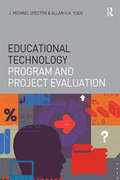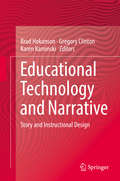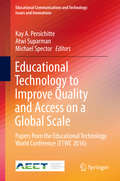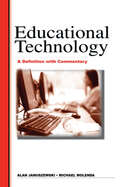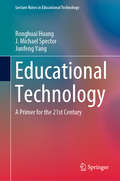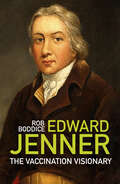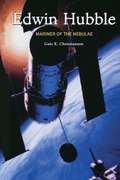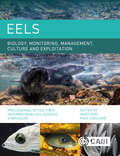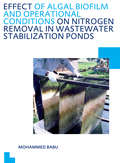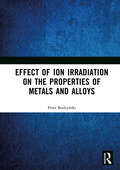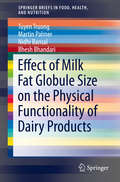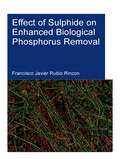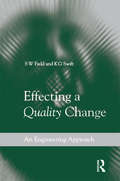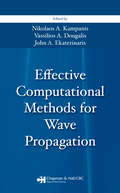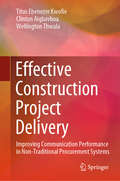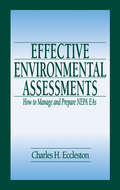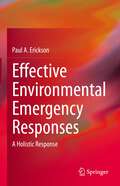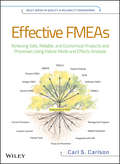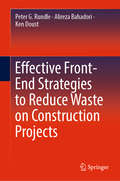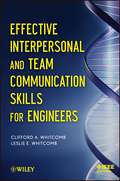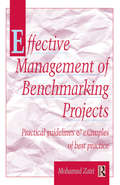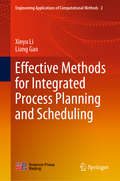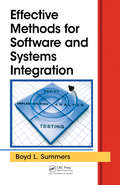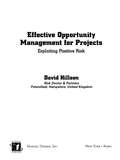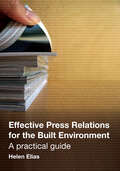- Table View
- List View
Educational Technology Program and Project Evaluation (Interdisciplinary Approaches to Educational Technology)
by J. Michael Spector Allan H.K. YuenEducational Technology Program and Project Evaluation is a unique, comprehensive guide to the formative and summative evaluation of programs, projects, products, practices and policies involving educational technology. Written for both beginning and experienced evaluators, the book utilizes an integrative, systems-based approach; its practical emphasis on logic models and theories of change will help readers navigate their own evaluation processes to improve interventions and conduct meaningful educational research. Key features include: evidence-based guidelines for constructing and conducting evaluations practical exercises to support the development of knowledge, skills, and program evaluation portfolios a variety of interdisciplinary case studies references and links to pertinent research and resources Using the TELL, ASK, SHOW, DO model first introduced in this series, Educational Technology Program and Project Evaluation provides comprehensive coverage of the concepts, goals, design, implementation, and critical questions imperative to successful technology-enhanced evaluation.
Educational Technology and Narrative: Story And Instructional Design
by Karen Kaminski Brad Hokanson Gregory ClintonThis volume is the result of a 2016 research symposium sponsored by the Association for Educational Communications and Technology (AECT) focused on the growing theoretical areas of integrating story and narrative into educational design. Narrative, or storytelling, is often used as a means for understanding, conveying, and remembering the events of our lives. Our lives become a series of stories as we use narrative to structure our thinking; stories that teach, train, socialize, and create value. The contributions in this volume examine stories and narrative in instructional design and offer a diverse exploration of instructional design and learning environments. Among the topics discussed: The narrative imperative: creating a story telling culture in the classroom. Narrative qualities of design argumentation. Scenario-based workplace training as storytelling. Designing for adult learners' metacognitive development & narrative identity. Using activity theory in designing science inquiry games . Changing the narrative of school: toward a neurocognitive redefinition of learning. Educational Technology and Narrative is an invaluable resource offering application-ready ideas to students of instructional design, instructional design practitioners, and teachers seeking to utilize theories of story and narrative to the ways that they convey and express ideas of instructional design and educational technology.
Educational Technology to Improve Quality and Access on a Global Scale
by Kay A. Persichitte Atwi Suparman Michael SpectorThis is an edited volume based on expanded versions of the best 30 papers presented at ETWC 2016 in Bali. Included are contributions from the keynote speakers of ETWC 2016: Robert Branch, Tian Belawati, Steve Harmon, Johannes Cronj#65533;, Marc Childress, Mike Spector, Chairul Tanjung, and Rudiantara. The work is organized into the following sections: (a) Effective Technology Integration in Teaching and Learning, (b) Quality Design, Development and Implementation, (c) Innovation and Creativity in Distance Education, and (d) Open Access, Courses and Resources.
Educational Technology: A Definition with Commentary
by Michael Molenda Alan JanuszewskiSponsored by the Association for Educational Communications and Technology (AECT), this book presents a definition of the field of study and practice known as educational technology or instructional technology. It reflects the collaborative efforts of all members of the AECT Definition and Terminology Committee. The volume begins with the statement of the definition itself (chapter 1), followed by commentary chapters on each of the key terms and concepts contained in the definition (chapters 2-9). Chapter 10 provides historical context for the current definition by reviewing salient elements of prior AECT definitions. Chapter 11 discusses ethical considerations and chapter 12 concludes by discussing ramifications of the current definition for academic programs in educational technology. This book is appropriate for anyone working in the field of educational technology: students, instructors, researchers and in-service providers.
Educational Technology: A Primer for the 21st Century (Lecture Notes in Educational Technology)
by J. Michael Spector Ronghuai Huang Junfeng YangThe aim of this book is to prepare students with knowledge and skills to understand the organizational needs and requirements of educational technology. Students should be able to use and manage both existing and emerging technologies effectively and be able to apply associated pedagogies to suit the environment, but also evaluate and manage technological advances of future and the requisite pedagogical shifts to achieve efficiency and effectiveness. The demand of educational technology has been rising steadily, primarily due to the fact that e-learning is a huge and significantly expanding world-wide industry. Commercial e-learning companies, training departments in large companies and organizations, computer software companies and educational institutions the world over employ large numbers of educational technology specialists. There is a strong demand for technologists who understand educational theories and for instructional designers and teachers who understand technologies. This book is targeted towards those who are looking for career in educational technology, instructional design, or media and information systems, or may want to continue their studies in graduate programs in learning and instructional technology, and those who are interested in becoming teacher in K-12 setting but need background in educational technology. This book will also act as a valuable resource in teacher education programs where primary focus on mainstream education and requires an authentic resource in instructional design and educational technology. Keeping in mind the varied needs of the organizations, employees and potential students, this book adopts a competency approach to learning and assessment. The themes and topics take a multi-disciplinary approach, and are aimed at preparing students for competent and innovative educational technology professionals.
Edward Jenner: The Vaccination Visionary (Pocket GIANTS)
by Rob BoddiceEdward Jenner is a giant of modern medicine. Throughout history, smallpox had plagued humanity with disfigurement, blindness and death. It was an incurable blight, the suffering of which Jenner helped to end.Surmising from the immunity of milkmaids that cowpox might be some defence against the ravages of smallpox, in 1793 he took some of the matter from a human case of cowpox and inserted it into the arm of a young boy. To test this, the first human-to-human vaccination, he subsequently inoculated the boy with smallpox itself, and found him to be immune from the disease. In 1979 smallpox was declared extinct.In this concise biography, Rob Boddice tells the story of Jenner’s life, his medical vision and his profound legacy. It is a story that encompasses revolutions in medical experimentation, public health provision and the prevention of other diseases, from anthrax to measles, but above all it highlights the profound impact that Jenner’s vision has had upon humanity’s battle against disease.
Edwin Hubble: Mariner of the Nebulae
by G.E ChrisitansonEdwin Hubble: Mariner of the Nebulae is both the biography of an extraordinary human being and the story of the greatest quest in the history of astronomy since the Copernican revolution. The book is a revealing portrait of scientific genius, an incisive engaging history of ideas, and a shimmering evocation of what we see when gazing at the stars.Born in 1889 and reared in the village of Marshfield, Missouri, Edwin Powell Hubble-star athlete, Rhodes Scholar, military officer, and astronomer- became one of the towering figures in twentieth-century science. Hubble worked with the great 100-inch Hooker telescope at California's Mount Wilson Observatory and made a series of discoveries that revolutionized humanity's vision of the cosmos. In 1923 he was able to confirm the existence of other nebulae (now known to be galaxies) beyond our own Milky Way. By the end of the decade, Hubble had proven that the universe is expanding, thus laying the very cornerstone of the big bang theory of creation. It was Hubble who developed the elegant scheme by which the galaxies are classified as ellipticals and spirals, and it was Hubble who first provided reliable evidence that the universe is homogeneous, the same in all directions as far as the telescope can see.An incurable Anglophile with a penchant for tweed jackets and English briars, Hubble, together with his brilliant and witty wife, Grace Burke, became a fixture in Hollywood society in the 1930s and 40s. They counted among their friends Charlie Chaplin, the Marx brothers, Anita Loos, Aldous and Maria Huxley, Walt Disney, Helen Hayes, and William Randolph Hearst. Albert Einstein, a frequent visitor to Southern California, called Hubble's work "beautiful" and modified his equations on relativity to account for the discovery that the cosmos is expanding.
Eels Biology, Monitoring, Management, Culture and Exploitation: Proceedings of the First International Eel Science Symposium
by Andy Don; Paul CoulsonThe freshwater eels, the Anguillids, have increasingly become the focus of attention for fisheries managers, scientists, researchers, policy makers, conservation bodies and other stakeholders. These species can be seen as a bellwether for issues affecting aquatic ecosystems - their steep decline and the management initiatives to try and reverse this trend, touch on subjects as diverse as disconnected waterways, loss of habitat, novel parasites, pollution, over-fishing and climate change. There are some 16 species of the Anguilla genus and all exhibit similar lifestyles, growing in waters often far-removed from their marine spawning grounds. These enigmatic, contradictory and confounding species share similar challenges and pressures wherever they are found. This book was generated from the 1st UK International Eel Science Symposium, which was held at the Zoological Society of London (ZSL) in June 2017. Hosted by the Institute of Fisheries Management (IFM), the ZSL and the Environment Agency (EA), the Symposium was heralded as a success, with over 180 delegates in attendance. Many of the world's top eel specialists attended or gave presentations across a diverse range of subjects. This was one of the Symposium's, and now the book's great strengths - its diversity of subjects and authors. Many countries are represented within the book, from across Europe and as far afield as New Zealand, South Africa, Vanuatu, French Polynesia, Japan, Canada and the USA. The EA and IFM have collaborated to produce this landmark book, which includes a mix of cultural, scientific and management information that will be invaluable to anyone with a professional or personal interest in these mysterious fish, including ichthyologists, fisheries scientists and managers, aquaculture personnel, environmental biologists and ecologists, marine and freshwater biologists, vertebrate zoologists, animal behaviourists and students studying in all these areas. Libraries in all universities and research establishments where these subjects are studied and taught should have copies on their shelves.
Effect of Algal Biofilm and Operational Conditions on Nitrogen Removal in Waste Stabilization Ponds: UNESCO-IHE PhD Thesis
by Mohammed BabuDischarge of nutrient rich wastewater causes eutrophication of surface water; therefore wastewater treatment before discharge is required. Wastewater stabilization ponds are low cost technology used by developing countries but not effective in nitrogen removal due to low nitrifier biomass in the water column. Introduction of surface area for attach
Effect of Ion Irradiation on the Properties of Metals and Alloys
by Piotr BudzyńskiThis book describes the interaction between ions and metallic targets as well as energy loss processes during ion implantation and irradiation. Ion bombardments of targets cause changes in surface layer chemical composition, radiation defect formation, sputtering, blistering, swelling and ion mixing. These effects modify surface topography, crystalline structure, electrical and tribological properties of metals and alloys. The book presents research on the effects of the implantation and irradiation on the friction and wear of modified materials, as well as practical applications of ion implantation and irradiation. It offers a review of current problems related to the modification of materials via irradiation. In addition, computer programs for modeling the depth of ions and vacancies in a sample are presented, and potential causes of disagreement between modeling and experimental results are described. Finally, the book provides evidence of the long-range effect.Effect of Ion Irradiation on the Properties of Metals and Alloys is aimed at academics investigating the properties of metals and alloys after irradiation and/or implantation as well as for students of engineering and physical and chemical sciences. The book is also useful for those looking for up-to-date information on these methods and ways of solving related problems, and for designers of equipment used in places exposed to high ion irradiation or to cosmic space.
Effect of Milk Fat Globule Size on the Physical Functionality of Dairy Products
by Bhesh Bhandari Martin Palmer Tuyen Truong Nidhi BansalEffect of Milk Fat Globule Size on the Physical Functionality of Dairy Products provides a comprehensive overview of techniques utilized to vary milk fat globule size in fat-structured dairy products. The text aims to highlight the importance of both native and emulsified milk fat globule size in the processing and functionality of these products. Both herd managements strategies and fractionation techniques utilized to vary milk fat globule size are covered thoroughly, as are the effects of mechanical sheer processing. The influence of different size fat globules on aspects such as TAG composition, physical stability, viscosity, crystallization properties and electric conductivity are studied, as are the influences on processability and function. This Brief aims to highlight the importance of milk fat as a determinant of the microstructural, rheological and sensorial properties of fat-containing dairy products such as milk, cream, yogurt, ice cream, cheese, butter and milk chocolate. Since milk fat globules have a widely varied size distribution, controlling their size is of major importance in processing. In comprehensively covering the various methods used to vary milk fat globule size, this text serves as an important resource for those involved in dairy product processing.
Effect of Sulphide on Enhanced Biological Phosphorus Removal: The Wolfram Language in the Real World (IHE Delft PhD Thesis Series)
by Francisco Rubio-RincónThe enhanced biological removal of phosphorus (EBPR) is a popular process due to high removal efficiency, low operational costs, and the possibility of phosphorus recovery. Nevertheless, the stability of the EBPR depends on different factors such as: temperature, pH, and the presence of toxic compounds. While extensive studies have researched the effects of temperature and pH on EBPR systems, little is known about the effects of different toxic compounds on EBPR. For example, sulphide has shown to inhibit different microbial activities in the WWTP, but the knowledge about its effects on EBPR is limited. Whereas the sulphide generated in the sewage can cause a shock effect on EBPR, the continuously exposure to sulphide potentially generated in WWTP can cause the acclimatization and adaptation of the biomass. This research suggests that sulphate reducing bacteria can proliferate in WWTP, as they are reversibly inhibited by the recirculation of sludge through anaerobic-anoxic-oxic conditions. The research enhances the understanding of the effect of sulphide on the anaerobic-oxic metabolism of PAO. It suggests that the filamentous bacteria Thiothrix caldifontis could play an important role in the biological removal of phosphorus. It questions the ability of PAO to generate energy from nitrate respiration and its use for the anoxic phosphorus uptake. Thus, the results obtained in this research can be used to understand the stability of the EBPR process under anaerobic-anoxic-oxic conditions, especially when exposed to the presence of sulphide.
Effecting a Quality Change: An Engineering Approach
by S W Field K G SwiftProviding an understanding of what is meant by quality and its unique position in a manufacturing environment to improve competitive business performance, this text defines all the fundamental ingredients required to introduce an improvement in quality. Concise and easy to read, the theory is backed up by numerous industrial experiences, illustrating the practical obstacles when implementing any quality change. Focusing on the essentials of quality (strategies, principles and techniques) designing for quality is also discussed and new techniques for assessing the risks and costs of non-conformance are introduced. The result is an insight to quality engineering that will prove invaluable to engineering students and professionals.
Effective Computational Methods for Wave Propagation
by Nikolaos A. Kampanis Vassilios A. Dougalis John A. EkaterinarisDue to the increase in computational power and new discoveries in propagation phenomena for linear and nonlinear waves, the area of computational wave propagation has become more significant in recent years. Exploring the latest developments in the field, Effective Computational Methods for Wave Propagation presents several modern, valuable
Effective Construction Project Delivery: Improving Communication Performance in Non-Traditional Procurement Systems
by Clinton Aigbavboa Wellington Thwala Titus Ebenezer KwofieThis book focuses on the development of communication skills in the context of non-traditional procurement and construction projects. It helps readers to understand the fundamentals of non-traditional procurement, and highlights the inherent communication challenges that arise, as well as how to solve them.The book is divided into four parts, the first of which provides an introduction to communication, discussing the theoretical concepts and contextual nature of communication as well as its benefits. The second part goes into more depth, discussing communication in the context of construction project delivery and non-traditional procurement systems, what these two terms actually mean, and what effective communication looks like in these contexts. Part III offers solutions to the inherent challenges of communication, including the use of information and communications technology, while the book’s fourth and final part explores the future of construction communication. Given the scope of its content, the book represents a valuable asset for researchers, professionals and students in the areas of procurement management and construction management.
Effective Environmental Assessments: How to Manage and Prepare NEPA EAs
by J. Peyton Doub Charles EcclestonAlthough upwards of 50,000 Environmental Assessments (EA) are prepared annually, the focus of the National Environmental Policy Acts (NEPA) Regulations is clearly on defining requirements for preparing environmental impact statements. Surprisingly, until now, there has been no authoritative and comprehensive guide on how to prepare Environmental As
Effective Environmental Emergency Responses: A Holistic Response
by Paul A. EricksonThis book focuses on the variety of subsequent consequences that may follow the conclusion of the immediate emergency response effort, consequences that require multi-disciplinary efforts and most likely may require a revamping of the historical interplay of national and other political authorities. The book is essentially a critique of contemporary emergency response which, in both the public perception and, unfortunately, in the mind-set of many practicing professionals emphasizes an emergency as a singular event. It is a mistaken view: an emergency is actually a sequence of multiple, singular events that unfold over time, sometimes measured in days and weeks and, most often, in months, years and decades. This book focuses on the need, in the current and recent past generation to revamp our thinking about planning for and responding comprehensively to those periodic disruptions to daily routine we call "emergencies".
Effective FMEAs
by Carl CarlsonOutlines the correct procedures for doing FMEAs and how to successfully apply them in design, development, manufacturing, and service applicationsThere are a myriad of quality and reliability tools available to corporations worldwide, but the one that shows up consistently in company after company is Failure Mode and Effects Analysis (FMEA). Effective FMEAs takes the best practices from hundreds of companies and thousands of FMEA applications and presents streamlined procedures for veteran FMEA practitioners, novices, and everyone in between.Written from an applications viewpoint--with many examples, detailed case studies, study problems, and tips included--the book covers the most common types of FMEAs, including System FMEAs, Design FMEAs, Process FMEAs, Maintenance FMEAs, Software FMEAs, and others. It also presents chapters on Fault Tree Analysis, Design Review Based on Failure Mode (DRBFM), Reliability-Centered Maintenance (RCM), Hazard Analysis, and FMECA (which adds criticality analysis to FMEA).With extensive study problems and a companion Solutions Manual, this book is an ideal resource for academic curricula, as well as for applications in industry. In addition, Effective FMEAs covers:The basics of FMEAs and risk assessmentHow to apply key factors for effective FMEAs and prevent the most common errorsWhat is needed to provide excellent FMEA facilitationImplementing a "best practice" FMEA processEveryone wants to support the accomplishment of safe and trouble-free products and processes while generating happy and loyal customers. This book will show readers how to use FMEA to anticipate and prevent problems, reduce costs, shorten product development times, and achieve safe and highly reliable products and processes.
Effective Front-End Strategies to Reduce Waste on Construction Projects
by Alireza Bahadori Peter G. Rundle Ken DoustThis volume outlines a progressively staged process focused on fostering a more effective, more efficient, and greener global construction industry. The research-based book commences with an evaluation of eight methodologies identified after a worldwide literature and compliance review. It is followed by a more detailed report on four of these options, with the ultimate objective of independent selection within the construction engineering community of a single most appropriate methodology as the approach for further, more-detailed investigation. The eight methodologies were selected against six key performance indicators developed as assessment criteria and include knowledge management, lean construction, construction contract procurement practices, optimal work duration on site, construction site waste, rationalization of construction safety regulations, sustainable construction labor force, and portfolio project development. A primary outcome of the selected methodology being a triple bottom-line benefit to key stakeholders, commercially and also to the ecology, along with the community at large. Front-end construction waste strategies to serve as best practices to minimize waste generated by construction projects was the methodology selected for detailed research. The text also covers the primary sources of construction waste. The book is ideal for civil and construction engineers as well as project developers; managers and public sector waste management specialists.
Effective Interpersonal and Team Communication Skills for Engineers
by Leslie E. Whitcomb Clifford WhitcombPresents key principles of communication that support clear exchanges in a technical context and help engineers learn effective communication skills Effective communication is a necessity for engineers. Even minor on-the-job misunderstandings can cost time, money, or worse. Yet even though recent studies show that improved communication makes for better engineers, the ability to speak clearly and listen carefully have historically been considered "soft skills" and are not typically or explicitly addressed in engineering programs. Working from basic units called microskills, Effective Interpersonal and Team Communication Skills for Engineers shows readers, one step at a time, how to engage, listen, manage conflict, and influence others with highly constructive, repeatable communication exchanges. This career-enhancing handbook: Presents communication skills for both technical issues and social situations in an engineering context Breaks skills down to elemental usage forms as microskills Includes plenty of practice exercises, case studies, and self-assessment tools Helps develop higher-level skills for more complex situations, such as dealing with confrontation and conflict negotiation Features a direct, user-friendly, practice-oriented format Effective Interpersonal and Team Communication Skills for Engineers is a must-have guide for professionals and an important supplement for engineering programs at all levels.
Effective Management of Benchmarking Projects
by Mohamed ZairiEffective Management of Benchmarking Projects shows you how to apply benchmarking to a variety of projects. Effective Management of Benchmarking Projects equips the project team or manager with all the necessary competence for managing projects effectively. This practical book begins with definitions of 'what to benchmark' and ends with a stimulating real case study where a benchmarking project was conducted by observing all the necessary rules and with total adherence to the various protocols.This book deals with the application of benchmarking. It gives real examples of effective applications from such companies as: Rank Xerox, D2D, American Express, Rover, Texas Instruments.
Effective Methods for Integrated Process Planning and Scheduling (Engineering Applications of Computational Methods #2)
by Liang Gao Xinyu LiThis book summarizes a series of research work on integrated process planning and scheduling (IPPS) done by the authors, focusing on discussing the properties, novel solution methods and applications of process planning, scheduling and IPPS problems under different machining environments. It is a valuable reference resource for teachers, students and researchers working in the fields of engineering, management science and other related disciplines.
Effective Methods for Software and Systems Integration
by Boyd L. SummersBefore software engineering builds and installations can be implemented into software and/or systems integrations in military and aerospace programs, a comprehensive understanding of the software development life cycle is required. Covering all the development life cycle disciplines, Effective Methods for Software and Systems Integration explains h
Effective Opportunity Management for Projects: Exploiting Positive Risk (Pm Solutions Research Ser. #Vol. 6)
by David HillsonWith step-by-step guidelines, this bestselling reference discusses the management of project opportunities by expanding the traditional risk management process to address opportunities alongside threats. It offers valuable tools and techniques that expose and capture opportunities, minimize threats, and deal with all types of uncertainty in your business and projects. Written by an experienced consultant and risk management specialist, this guide emphasizes that risk processes must cover both opportunities and threats if they are to assist in accomplishing project objectives and maximizing business benefits.
Effective Press Relations for the Built Environment: A Practical Guide
by Helen EliasThis practical guide explains to architects, engineers, designers and other consultants how to establish press plans for firms and for individual projects, and how to actively develop reputation by getting work published in the architectural, engineering and construction press. With quotes, advice and opinions from the industry's key journalists – including expert image generation and selection advice from Gareth Gardner, photo-journalist and past editor of FX and Features editor of Building Design – Effective Press Relations for the Built Environment, offers practical guidance on topics such as: how to approach planning a strategy for a project how to write, seek approval, build a target press list and issue the information to magazines how to speak to the press how to manage a crisis and handle bad press. With its hands-on approach and comprehensive publications, architectural photographers and PR consultants listings, this book is an invaluable tool for new starters, or larger firms that want to take a more pro-active role in generating their own publicity, while also helping practices to get the most from their press relations consultant.
